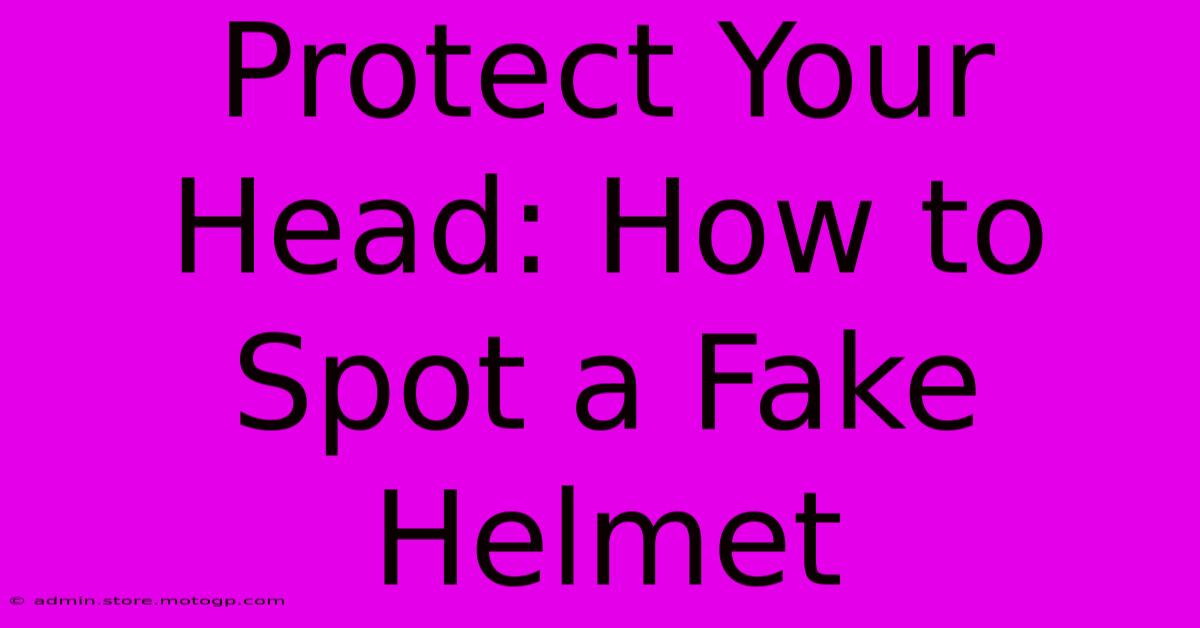Protect Your Head: How To Spot A Fake Helmet

Table of Contents
Protect Your Head: How to Spot a Fake Helmet
A helmet is your first line of defense against serious head injuries, whether you're cycling, motorcycling, skateboarding, or participating in other high-impact activities. But what happens when the very thing designed to protect you is actually putting you at risk? The alarming reality is that counterfeit helmets are flooding the market, offering a false sense of security that can have devastating consequences. This guide will equip you with the knowledge to spot a fake helmet and ensure you're investing in genuine protection.
The Dangers of Fake Helmets
Counterfeit helmets are often made with substandard materials and lack crucial safety features. They may not meet any safety standards, offering significantly less protection in a crash. The consequences can range from minor injuries to severe head trauma, even death. Don't gamble with your safety. The cost of a genuine helmet is a small price to pay compared to the potential cost of a serious injury.
Identifying the Red Flags: Key Indicators of a Fake Helmet
Several telltale signs can help you identify a potentially fake helmet. Pay close attention to these details:
-
Price: If a helmet's price is significantly lower than comparable models from reputable brands, be wary. Authentic helmets from established manufacturers rarely come at bargain-basement prices. Think quality over quantity.
-
Packaging and Labeling: Examine the packaging carefully. Look for inconsistencies in printing, spelling errors, or poor-quality graphics. Authentic helmets typically come with clear, well-printed labels displaying relevant safety certifications (like DOT, ECE, Snell, or CPSC). Missing or blurry certifications are a major red flag.
-
Manufacturing Quality: Inspect the helmet's construction. Look for loose stitching, uneven paint jobs, or poorly finished edges. A genuine helmet will exhibit a high level of craftsmanship and attention to detail. Poor build quality indicates potential compromise in safety.
-
Sticker placement: Check the placement of stickers and labels. On genuine helmets, these are typically placed neatly and accurately. Misaligned or poorly affixed stickers could be a sign of a fake.
-
Weight: While not always definitive, unusually light or heavy helmets can be suspect. A helmet that feels significantly different in weight from others of the same type should raise concerns.
-
Straps and Buckles: Inspect the chin strap and buckle mechanism. A flimsy or poorly constructed strap, or a buckle that doesn't function smoothly, are signs of inferior quality.
-
Internal padding: Check the interior padding for quality and even distribution. Inadequate padding is a sure sign that the helmet won't offer adequate impact protection.
Where to Buy Authentic Helmets
To ensure you're getting a genuine, safety-certified helmet, buy only from authorized retailers and reputable sources. This includes:
-
Authorized Dealers: Purchase from official brand stores or authorized retailers listed on the manufacturer's website.
-
Established Sporting Goods Stores: Reputable sporting goods stores typically stock authentic helmets.
-
Online Marketplaces (with Caution): While online marketplaces can offer convenience, exercise extra caution. Read reviews carefully and only buy from highly-rated sellers with a proven track record. Avoid suspiciously cheap deals.
Beyond the Visual: Understanding Safety Certifications
Understanding helmet safety certifications is crucial. These certifications signify that the helmet has undergone rigorous testing and meets specific safety standards. Look for markings indicating compliance with:
- DOT (Department of Transportation): Required for motorcycle helmets in the United States.
- ECE (Economic Commission for Europe): A widely recognized standard in Europe.
- Snell: A stringent independent testing standard for various types of helmets.
- CPSC (Consumer Product Safety Commission): Applies to bicycle helmets in the United States.
Investing in a genuine helmet is an investment in your health and safety. Don't let a counterfeit helmet jeopardize your well-being. By following these tips, you can confidently choose a helmet that offers the genuine protection you deserve. Your safety is priceless.

Thank you for visiting our website wich cover about Protect Your Head: How To Spot A Fake Helmet. We hope the information provided has been useful to you. Feel free to contact us if you have any questions or need further assistance. See you next time and dont miss to bookmark.
Featured Posts
-
Moto Gp Arcade Game The King Of Arcade Racing
Feb 18, 2025
-
The Importance Of Practice In Motorcycle Racing
Feb 18, 2025
-
Moto Gp Qualifying Results Shock Upsets And Last Lap Drama
Feb 18, 2025
-
The Science Behind Motorbike Racing Performance
Feb 18, 2025
-
Witness Cota History With General Admission
Feb 18, 2025
